Customer satisfaction has a massive impact on your business’ success. A low satisfaction level means your customer retention and loyalty levels will likely be low, too, and it’s also a sign of bad customer service – a huge problem that costs businesses up to $62 billion per year!
Well, we’ve compiled this thorough list of 19 great customer service tips showing how to improve your customer satisfaction levels and boost loyalty.
We’ve also added some quick links on the left in case you’re in a hurry and want to jump to a specific section.
Now, let’s dive in:
1. Create Memorable Customer Experiences
Unique customer experiences are key to getting people to trust your brand and buy from you. A Wunderman study reveals that around 79% of consumers prefer to only do business with a brand that shows it actually cares about them.
Moreover, customer experience has become increasingly influential in shaping customer satisfaction. In fact, it was bound to overtake both price and product as the main brand differentiator by 2020. That means focusing on offering amazing experiences to your clients is no longer an option but a must.
So, let’s get started:
1. Address Your Customers by Name
One of the best ways to offer a more personal customer experience is by using the customer’s name when talking with them – in person, over the phone, through email, or when coming up with customer surveys. A friendlier approach that doesn’t feel forced humanizes the consumer-business interaction.
Take the example of Starbucks, one of the top brands enjoying a high NPS score and billions in revenue. Starbucks employees always address their customers by name when greeting them, calling their drink, or thanking them for their visit. This approach sets the premises for a long-lasting relationship built on recognition – considered to be the foundation for great customer service.
Keep in mind that, according to research, people become ecstatic when they hear their name called. And let’s not forget Dale Carnegie’s famous advice from his book “How to Win Friends and Influence People” (a top-rated book on business communications skills):
“Names are the sweetest and most important sound in any language.”
2. Always Send Personalized Messages/Replies
When a customer signs up for your free trial or purchases your product, do you reach out with a personalized email or send a generic onboarding sequence?
Automated onboarding sequences are fantastic for helping users become familiar with the product, especially if it has a steep learning curve. But they’re far from personal and don’t welcome users as a personal message can.
When a customer purchases your product, signs up for your free trial, or sends an inquiry, reach out personally to ask how you can help them. Even if most customers don’t accept your help offer, they’ll appreciate the gesture and form a more favorable impression of your business.
Moreover, first impressions are the most lasting ones, so it’s important to start off on the right foot and keep up the pace to be able to yield long-lasting relationships with your customers.
Research led by Experian Marketing Services shows that personalized emails:
- Have 29% higher open rates
- Have 41% higher click rates
- Deliver 6 times more transaction rates
Also, around 96% of marketers say that this kind of personalization improves customer relationships.
So, how do you personalize the messages you send to customers?
Obviously, first of all, use the recipient’s name when addressing them. You could also send the message in the customer’s native language if you know they’re based in a different country. Though, you should only do that if you’re sending out a message the customer isn’t expected to reply to.
Other ways you should consider:
- Using a friendly, informal, or familiar tone and style of writing
- Using a personalized email to send the message instead of a generic corporate one (“[email protected]” instead of just “[email protected]”)
3. Give Clients Personal, Old-Fashioned Contact
In the age of automated everything, being a little old-fashioned can greatly benefit your business.
Paul Graham’s famous advice to do things that don’t scale is just as valuable for improving your customer satisfaction as it is for acquiring customers. From phone support for your top customers to letters and holiday cards, your customers will notice when you offer service that doesn’t scale.
You should never underestimate the power of thanking your customers for doing business with you – and we’re not talking about setting up a banner on your homepage saying that. Don’t forget – around 60% of businesses lost customers because they felt the brand was too “indifferent” towards them.
Thank-you notes help you show clients how much you value them and that your brand views them as people, not just a source of profit.
That’s why you should send out thank-you notes to customers whenever possible. Consider shipping your products alongside individual thank-you notes if your budget allows it. If your business has a subscription-based model, you can mail the notes to your customers.
And make sure that the notes are customized and hand-signed – don’t just send out emails or print out a generic message typed into Microsoft Word. Be sure to personalize the cards – handwrite the customer’s name and make the signature follow the same logic, as well as customize the card’s tone, look, and writing style to reflect your brand.
Keep in mind that thank-you notes done right can generate word-of-mouth advertising for your business. How? It’s pretty simple – customers get the notes, are pleasantly surprised, and they post a picture (or more) of it online for all their social media followers to see.
One last idea – consider sending out holiday cards, too, especially during more “unique” holidays like Groundhog Day. It makes you stand out more.
4. Turn Customer Mistakes Into Unforgettable Experiences
Sometimes, it’s not the company that makes a mistake but the customer. It happens, and even though it’s the client’s fault, that doesn’t mean you shouldn’t try to come up with a solution. It shows people how much your brand cares about consumers, and it really takes the customer who made the mistake by surprise in a pleasant way.
Warby Parker is an excellent example of turning a customer mistake into a great customer success story. Basically, a client forgot their pair of glasses on a train, and the person who sat across recovered the glasses. That person – Anjali Kumar – also happened to be a Senior Executive at Warby Parker.
Besides just retrieving the glasses, Anjali went the extra mile and sent over an extra pair of new glasses (saying they noticed the original lenses were a bit scratched) and a personalized note.
The result? The customer in question wrote about this event online, and it got so popular it ended up being a hit story on Forbes.
So, let your employees know that if they ever see an opportunity to fix a client’s mistake in a way that would benefit the company’s image, they should go ahead and do it – even if it’s not during work hours. Just be sure to set a budget for things like that.
In terms of budget, you should also consider that providing unforgettable experiences does not necessarily imply spending a lot, but investing emotionally – through compassion and thoughtfulness. There is no need to wait for a mistake to act on; you can turn a special but exhausting day in your customer’s life into a memorable experience with your company.
A perfect example in this respect is the way United Airlines acted towards one of their customers on his flight to Arizona to meet his birth mother. A really emotional day for Jason Dorn, no doubt, and the airline went above and beyond – from start to finish – to make this challenging trip better with kind words, a glass of wine, and even a present on the way back.
The client posted about his experience on social networks, thanking United Airlines for encouraging their employees to go the extra mile for their customers. The post, of course, did not go unnoticed, giving a great opportunity to the company – current and former employees – to engage with their customer online and express support, as well as their pride for being part of the airline’s team. Here are just a few of those comments:
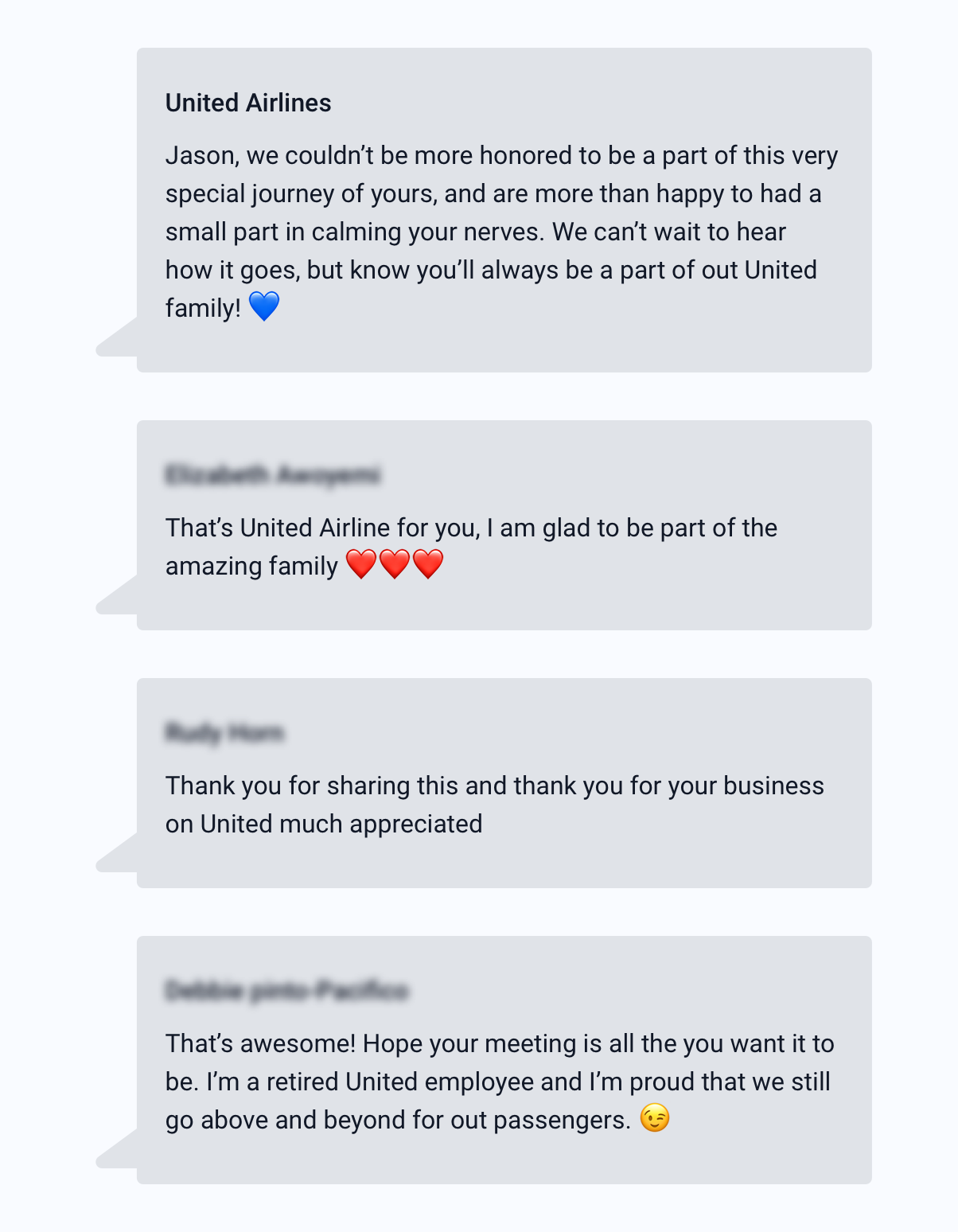
The post captured the attention of many people who shared the importance of this special moment in Jason’s life and acknowledged the wonderful job that United Airlines has done.
A small gesture prompted thousands of reactions and hundreds of comments in just a few days, generating positive word-of-mouth for the company. This will definitely have a great impact on the airline’s image, surface the brand’s Promoters, win over a bunch of customers, and foster loyalty towards the brand. Here are just a few comments to prove the point:
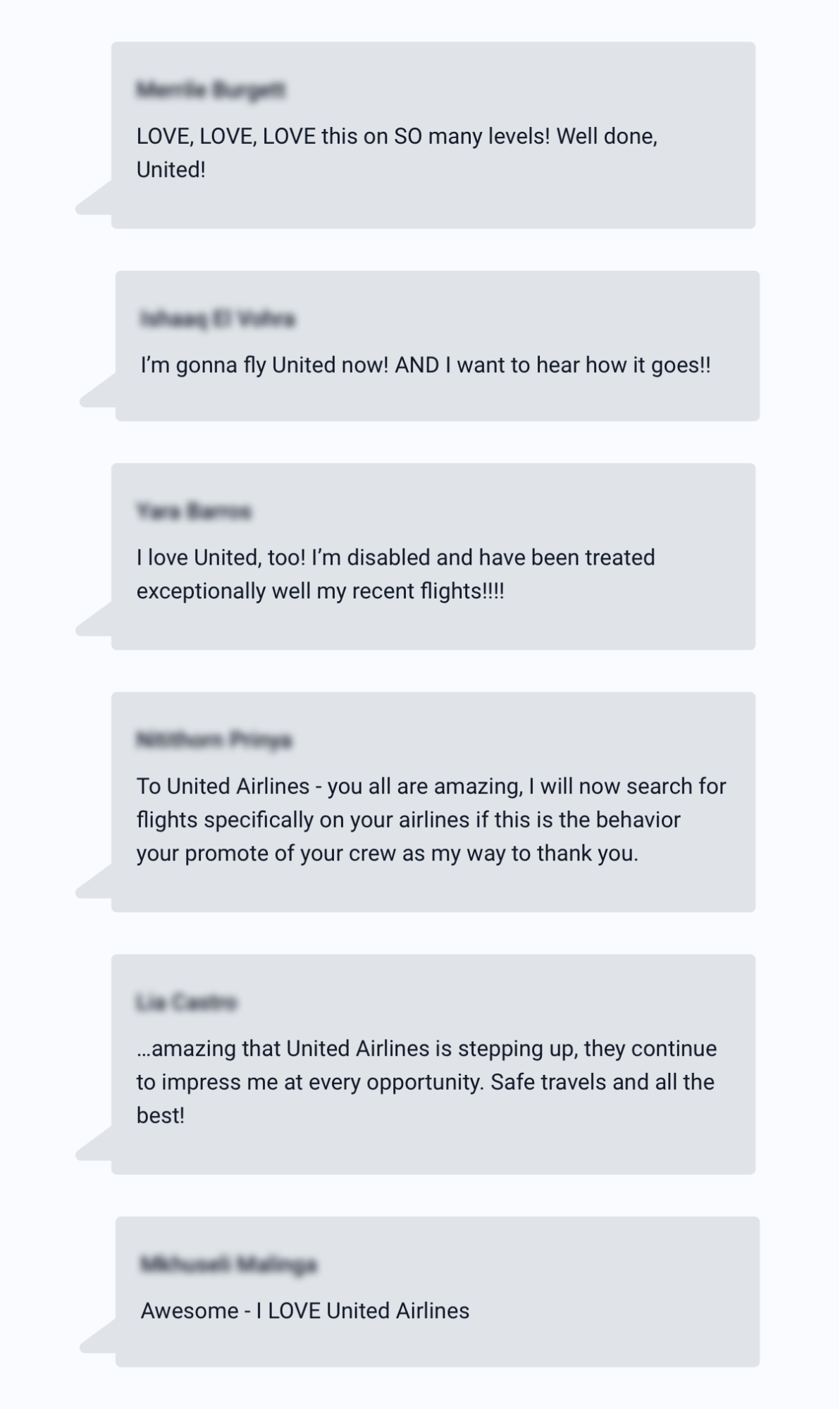
Many of the comments to the post focused on how impressive the airline’s act was, using such words as “wonderful”, “amazing”, “awesome”, “bravo”, “United inspires”, etc. Yet, there will always be someone who will have a cautious look at the situation, thinking of how one found the customer, how they could trace his flight, etc. – someone who can not decide if the action was fantastic or actually creepy.
This example was not an exception in this respect. However, positive reactions overwhelm outlining an example of great customer service, while the client’s posts speak of gratitude towards the gesture and, most certainly, a loyal customer in the long run.
5. Reward Loyal Customers
Modern consumers want personalization. It’s what drives more sales and customer loyalty. Generally, the best way to offer them a personalized experience is to run a loyalty program since it makes it easier for you to collect relevant customer data. If we analyze data from client loyalty programs, we shall find out that around 79% of consumers are more satisfied with programs that offer a high degree of personalization.
So, the idea is to wow loyal clients with an experience they won’t forget any time soon, something that is really relevant to their taste.
For example, say you run a brewery. You could reward long-term customers who promote your brand online with free beer shipped right to their doorstep, but why not surprise them with a tour of your brewery instead?
Alternatively, you could offer them free beer, but you could make the whole experience more meaningful by customizing the labels with each customer’s photos, names, or other relevant information.
The end result would likely be the same in both cases – you’d get to enjoy the word-of-mouth advertising online that would significantly improve your brand’s image.
That’s just an example, and you can approach this however you think it’s more suited to your business.
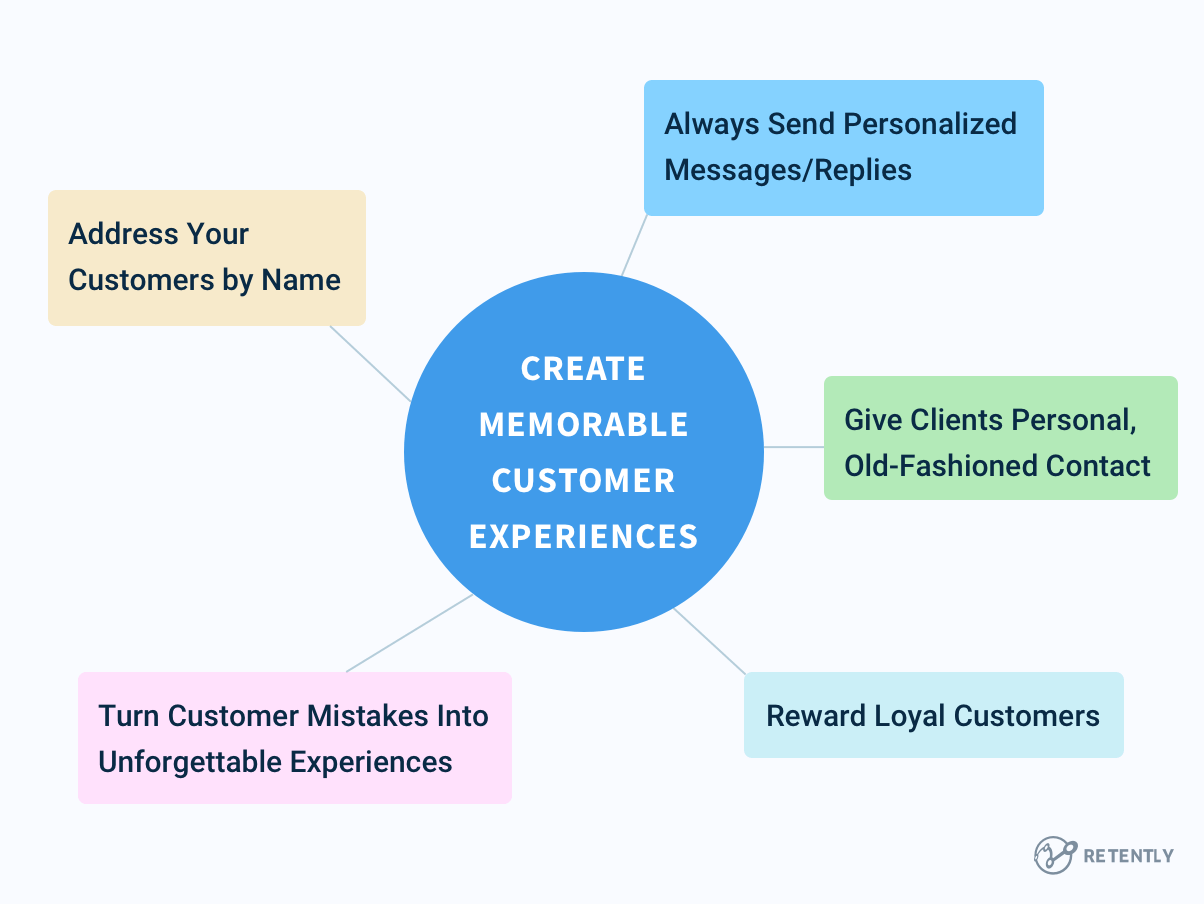
2. Provide Fast, Convenient Customer Support
When consumers bump into a problem with your products/services or have a question about your brand nowadays, they expect you to offer a quick, decent response. Think about it – people today don’t usually get to enjoy a lot of free time. Thus, spending even half an hour dealing with customer support can seriously harm customer satisfaction.
Speculations aside, though, the research backs up this claim. According to Forrester, 73% of online adults in the US claim that the best thing a brand can do to offer them great customer support is to “value their time.”
So, here are a few pointers for that:
6. Offer Omnichannel Support
How easy is it for your customers to contact you? One of the most common complaints of SaaS customers is that getting in touch with support – particularly a real, live person – can take days, after which they’ve already searched and found an answer to their question or canceled the service.
If you’re not familiar with the idea of omnichannel support, it basically means having a presence and a customer experience strategy in place on any channel where your clients are active.
Consumers nowadays use multiple channels and devices to shop around. It’s just more convenient and easy for them, and your support strategy must cover all that.
For example, if you were to run a chain of retail stores, your strategy should cover:
- In-person interactions with the staff
- Social media support (the exact platforms your customers use)
- Email support
- Phone support
- Live chat support
All of that to ensure the customer has a seamless experience no matter the channel they use.
About 64% of consumers expect you to offer them access to real-time support no matter the channel they use. Another study shows that, during holidays, 90% of consumers want a consistent experience across all channels and devices.
In terms of profitability, a strong omnichannel approach has the potential to increase your revenue year-over-year by approximately 9.5%. At the same time, companies offering efficient omnichannel support retain, on average, 89% of their customers.
Make it as easy as possible for your customers to contact you, and you’ll notice an improvement in their perception of you. Email software provider Ontraport does a fantastic job in this respect by listing their 800 support numbers right at the top of their support page.
If you offer live chat support, list the hours on your website so users can always be informed about when they can and can’t contact you. If it takes 24+ hours to respond to emails, let users know as soon as they contact you so there’s no confusion.
Most customers will tolerate a slower-than-average response and understand that it takes time to solve problems, but only if you let them know. Make your support process as transparent and easy as possible, and you’ll have happier customers who feel genuinely cared for.
7. Respond on Social Media
When customers contact your brand on social media – to ask for support, leave a complaint, or address a question – they’re not doing it only because it’s easy and convenient. They’re also doing it because they expect a fast response.
According to various data, around 42% of consumers expect a response from your brand within 60 minutes once they post a complaint. 32% of them expect a response within 30 minutes! Hubspot’s data says something similar – approximately 72% of customers who complain on Twitter want a response from the company within an hour.
If you don’t respond on time, people will most likely complain about that to their friends and social media followers. What’s more, platforms like Facebook make it easy for users to see your average response time.
Overall, it’s in your best interest to either have an employee focused only on tracking and responding to social media comments or an entire department, if possible. It will boost customer satisfaction and can apparently increase customer advocacy by up to 25%.
8. Use Non-Generic Auto-Replies
Auto-replies are a good idea because they give customers a clear confirmation that their message was received. Some people might think their request or question didn’t go through if they don’t receive such confirmation.
However, don’t fall into the trap of using plain auto-replies. Make them more interesting and engaging by adding some personality to the mix. Instead of having the subject line be “We received your support request,” make it more friendly, like “Hi – thanks for getting in touch. We’re on it.”
Also, if the software allows it, have the reply use your customer’s first name. Oh, and be sure to thank clients for the emails – either in the subject line or the email body.
Afterward, make sure one of your employees follows up with the customer. Ideally, they should follow up before the deadline promised by the auto-reply. So, for example, if the reply says you’ll get back to your clients in 24 hours, do it in 3-5 hours instead.
Basically, the idea is to use software to under-promise and then have a human employee over-deliver. That’s definitely a sure way to improve customer satisfaction and trust in your brand.
And when possible, use auto-replies on social media and follow the same strategy. Facebook offers such a feature, for instance.
9. Provide Self-Help Options
Some modern consumers prefer helping themselves rather than going through a customer support rep or process. According to a Zendesk survey of 7,000 respondents, around 53% of people considered it was more important to be able to resolve their service-related problems by themselves.
One way to offer self-help features is to provide access to an in-depth Knowledge Base or FAQ section. Spot the most common complaints and questions and answer them in thorough articles and step-by-step tutorials.
After all, 91% of people would be happy to use a single online Knowledge Base if it’s tailored to their needs. Also, the use of help and FAQ sections increased to 81% among US adults.
You could even combine the FAQ/Knowledge Base section with the auto-reply we discussed above. Link it in the email body so that customers can check it out if they want to until you get back to them. They might actually find the solution they need.
Another thing you can try is using a support chatbot. Approximately 57% of respondents to a Hubspot survey confirmed they were interested in the idea of dealing with a chatbot. Plus, chatbots can help reduce customer service costs by up to 30%, according to IBM.
10. Offer 24/7 Customer Support
Given how important it is to offer consumers fast response rates, it’s clear the only way you can do that is by having a dedicated customer support team or department that works 24/7 – especially if you have a large customer base.
The best way to offer such support is to hire multiple customer reps and have them work in shifts. If you don’t have a big enough budget, you should also consider outsourcing customer support positions to freelancers – either in your country or abroad – since it lets you save money on renting office space.
Using a support chatbot can help with this, though you shouldn’t rely on it all the time. The Knowledge Base/FAQ sections we previously discussed can help with the “24/7 feel” as well.
Live chat features come in handy, too, since they allow customer reps to work remotely so that they can be available more often.
Besides that, consumers like the idea of live chat, which can potentially increase your company’s revenue. In fact, according to ICMI, website visitors who use live chat are worth 4.5 times more than the ones who don’t.
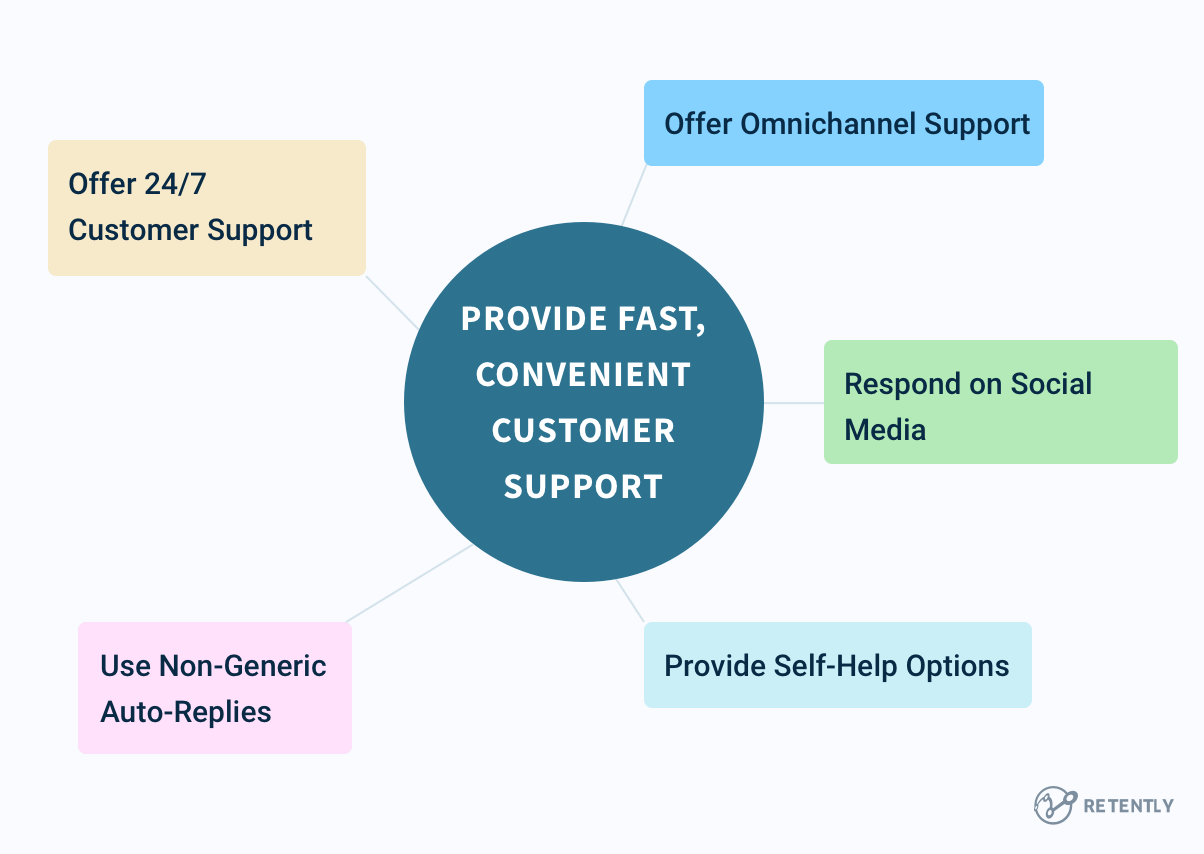
3. Make an Irresistible Offer
One mistake many business owners make when it comes to the things we’ll be discussing in this section is thinking they are making compromises and sacrifices that are hurting the brand financially.
In reality, offering consumers an “irresistible offer” is all about reducing purchasing anxiety through various means to help them have an easier time trusting your services and products. So they will be much more likely to buy from you than your competitors.
So, here are a few pointers to help you with that:
11. Offer a Lenient, Straightforward Refund Policy
It’s usually a good idea to offer a money-back guarantee to consumers since it increases their trust levels in your brand. It also makes the whole purchasing experience feel risk-free, so people are more likely to try your products and services.
But most businesses nowadays offer some sort of refund policy, so just advertising that isn’t always enough to stand out from the competition.
That’s why you should strive to, first and foremost, make your refund policy easier to understand for the average consumer. We recommend leaving out complicated legal jargon, which will likely confuse customers. Use bulleted lists to showcase the eligibility requirements and clearly outline any deadlines or options people need to consider.
Ideally, you should have the complicated refund terms and legal jargon on your Terms of Services page, and have a separate landing page or FAQ article discussing how your refund policy works in plain words.
Besides that, aim to keep your money-back guarantee flexible and lenient. A 30-day guarantee is always great, but you could always go the extra mile to wow your customers with a 60 or 90-day guarantee. Offering a “no-questions-asked guarantee” is also a nice touch. Essentially, whatever helps you meet or exceed your competitors’ refund policies from your customer’s perspective is always a smart move.
12. Offer a bulletproof guarantee
The riskier it is for a customer to buy your product, the more a guarantee can help assure your customers that you care about their experience.
If you sell a physical product, you can reduce the risk for customers by guaranteeing that the product will meet their expectations. The more customers feel they’re protected against risks, the more positively they’re likely to view your brand (and, by extension, your product).
Brands like JanSport have taken this to the extreme by offering lifetime warranties on many of their products. While your guarantee doesn’t need to last a lifetime, proving that you’re there for your customers goes a long way toward creating positive sentiment.
We’ve already discussed the importance of making the refund policy easier to understand by using basic terms. But, if you want, you can do something extra and add your brand’s voice in the text.
For instance, if your target audience is average, laidback people in the 20-40 age bracket, you could use a friendlier, more direct, and personal tone when describing the money-back guarantee terms.
At the same time, you should consider adding extra text on the refund policy page to let people know that if they ever encounter an issue, they can always rely on your customer support – and link the appropriate pages. You can even have a customer support or live chat prompt pop up when people want to request a refund.
Another thing you can try is directly linking your money-back guarantee to customer satisfaction – basically, stating outright that if a client isn’t 100% satisfied with your products/services, they can request a refund. This adds an extra level of trust in your brand and shows consumers just how much you care about helping them, not just selling them a product or a service.
13. Provide a Trial Period
In the early days of the SaaS world, businesses quickly discovered that a free trial took the guesswork and risk out of buying a product. Today, startups don’t debate the value of a free trial – they argue which trial period is the most effective.
With a free trial, potential customers are less worried about buyer’s remorse and risky investments because there’s no upfront fee.
A couple of things to note about free trials:
- Don’t ask people for credit card details when registering a trial account.
- Let consumers use their social media accounts to register a trial account if possible – it’s much easier for them.
- Don’t impose any limitations – let trial users enjoy as many features as possible to experience the actual value of your product/service.
- Don’t be too aggressive with promoting your subscriptions during the trial period. You can have a “Pricing/Upgrade” tab present in the trial version or just notify users about upgrading to the paid version when their trial is almost over.
Combine a properly-done free trial with a decent refund policy, and you’ve got quite a powerful way to motivate people to try out your products and services.
Oh, and in the case of ecommerce products, you can offer clear demo videos of the items you sell – since trials don’t really work. Make sure the videos showcase everything – how the product looks from different angles, how it works, how to assemble it, how big it is, and other relevant information.
14. Try to Offer Free Return Shipping
Many retailers are often uncertain about this because they feel like they will be losing money by having to cover or refund shipping costs for the customer.
But the reality is completely different – according to research, 88% of consumers claim that free return shipping has a big influence on their purchase decisions. Also, 67% of survey respondents said that free returns would encourage them to purchase more online.
Some people feel this policy can easily be abused. However, that can be counteracted by having a proper refund policy in place that clearly states the eligibility requirements.
In the worst-case scenario, if you are a smaller business or on a tighter budget, you can offer free return shipping for specific products, not all of them. After all, not even Amazon offers free return shipping for every product they sell.
15. Experiment with Discounts
Discounts are always a great incentive to get people to buy from you. According to Shopify’s research, merchants offering an active discount code are 8 times more likely to make a sale.
You can just have a page on your website where you display the first-time buyer discount code, as well as the monthly code – or any other discount code for that matter. You could also send customers emails to let them know about the various discounts.
Another thing you could try is running giveaways. That can work well if you offer a subscription-based service – customers could win a free extra month of service, for instance, or a subscription to share with their friends and family. Plus, you’d be able to drive much social media engagement by having users share giveaway-related posts.
Free shipping is another thing consumers tend to perceive as a “discount” – given the overall price will be lower with it. Don’t forget – 9 out of 10 consumers say that free shipping is the #1 incentive to shop online even more.
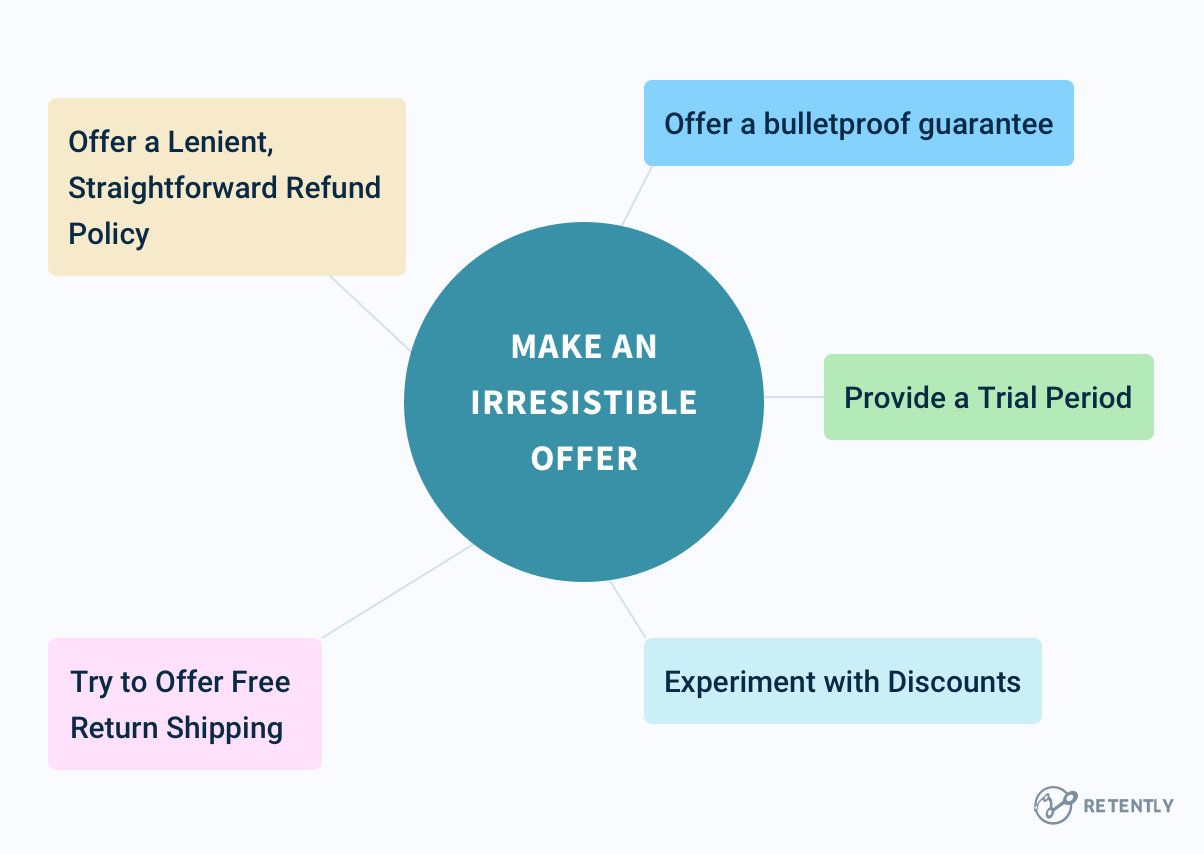
4. Make Feedback Part of Your Brand
Customer feedback is one of the most important assets your business can have. It can tell you a lot about your customer satisfaction levels since feedback is a clear indicator of how happy consumers are with your brand, services, and products overall.
Plus, customer feedback can also help you improve your services and products. It provides critical data that guide smarter business decisions. Also, taking feedback seriously shows consumers how much you value their opinions.
What’s more, according to a Gartner survey, companies that implemented customer experience-focused projects back in 2015 started out by collecting and analyzing consumer feedback. So, to offer customers a great experience, you need to know their opinions, complaints, and suggestions first.
With that out of the way, here’s how you can make your business more feedback-centric:
16. Actively Ask Customers for Feedback
Don’t just wait for clients to leave feedback – be proactive and ask them whenever you get an opportunity. Send them a survey after the purchase or an interaction with your support team to find out how satisfied they were with your business.
You could also run social media polls asking customers to rate which part of their interaction with your brand they like the most and to comment on what improvements they’d like to see. Make sure to run surveys to gauge customers’ reactions and expectations when introducing a new feature, product, or service. Why? Because it’s a sure way to boost customer satisfaction levels once you deploy it.
Think about it – you’ll know for sure that people will be willing to pay for what you will be offering, so the risk of a new investment is reduced on your behalf. And your clients will be happy not only because they will be getting something truly tailored to their needs, but also because you recognize how valuable their input is.
In this context, the term Voice of the Customer is worth mentioning, as it represents your target clients’ needs, desires, and dislikes. It’s basically data that helps you offer customers a solution they really need, not just an average product or service.
Net Promoter Score© surveys are also a great way to ask for valuable feedback. If you’re not familiar with them, they are basically 1-question surveys that ask clients how willing they are, on a scale from 0 to 10, to recommend your business, products, and services to other people. The questions can also be open-ended if you want to ask customers for more in-depth feedback.
Depending on how people answer, they can be segmented into:
- Promoters (loyal customers who promote your brand)
- Passives (customers who need an extra push to become loyal)
- Detractors (lost and upset customers)
With that kind of info, you can collect even more relevant feedback. For instance, Detractors and Passives are a great source of constructive criticism (sometimes, it can be rough, but it’s still useful information). At the same time, Promoters can provide you with excellent suggestions for potential features and products.
17. Share Feedback Across All Departments
It’s not enough to just have your frontline employees collect customer feedback, analyze and respond to it. That kind of info must be shared with all employee departments – including management.
What if the main customer complaints are related to a problem that can only be solved if the management gives the product development team the go-ahead to work on it? You will never address the customers’ needs if you don’t escalate the feedback to the higher-ups in the company.
Besides that, you should also consider encouraging people in management positions – or at the very least employees in senior positions – to put some time aside each month or each week to analyze the gathered customer feedback, and extract the main pain points and suggestions from it.
Afterward, the main data can be structured in different formats (like infographics, videos, PDFs, and so on) and shared with other departments through company emails or newsletters. We recommend sticking to more visual content since it makes it more engaging for employees.
What’s the payoff, you ask? Well, pretty much all your departments will know exactly what your customers expect from you, and will thus have an easier time coordinating their efforts.
18. Reply to All Feedback (Both Positive and Negative)
Getting positive reviews is always great for any business, but you’re not making the most of them if you don’t take the time to reply to those reviews as well. After all, reviews and how you respond to them can influence your search engine ranking.
Google says that responding to reviews enhances your business’ visibility online, making potential clients much more likely to visit or do business with you.
Also, it’s best if you or someone in management does that, as a reply from one of the higher-ups means more to consumers. Apparently, 78% of consumers say that if management responds to their online reviews, it makes them feel like the brand cares more about them.
Be sure to respond to both positive and negative reviews. In both cases, thank the customer for taking the time to give you valuable feedback. And when dealing with negative reviews, make sure you apologize too – it can double customer satisfaction compated to just offering them compensation.
If you’re looking for more ideas on how to respond to reviews, here are a few examples that might help you out.
19. Focus on Common Complaints & Provide Solutions
This is something your management team should primarily handle. The idea is for them to take a close look at your customer feedback, and identify the main 3-5 common, recurring complaints people have.
NPS surveys are really useful in this case since, to get the best results, you should look at the common complaints both Detractors (angry customers) and Passives (customers who like your brand but don’t “love” it) have.
Once the most common complaints have been identified, it’s time to prioritize them according to the frequency of mention. It’s obviously better to fix the problem most people are complaining about and mentioning the most first. However, you can also prioritize complaints that overlap both Passive and Detractor groups.
In case it’s a bit hard to pair up complaints because the feedback is vague, try to group them according to themes in improvement categories – like “speed up support replies,” “clarify ToS terms,” or “streamline onboarding process.”
When the problems are fully identified and prioritized, notify the appropriate employee departments and give them access to all the data they need in an engaging, easy-to-read/watch format. And don’t forget to emphasize the sense of urgency in fixing the problems.
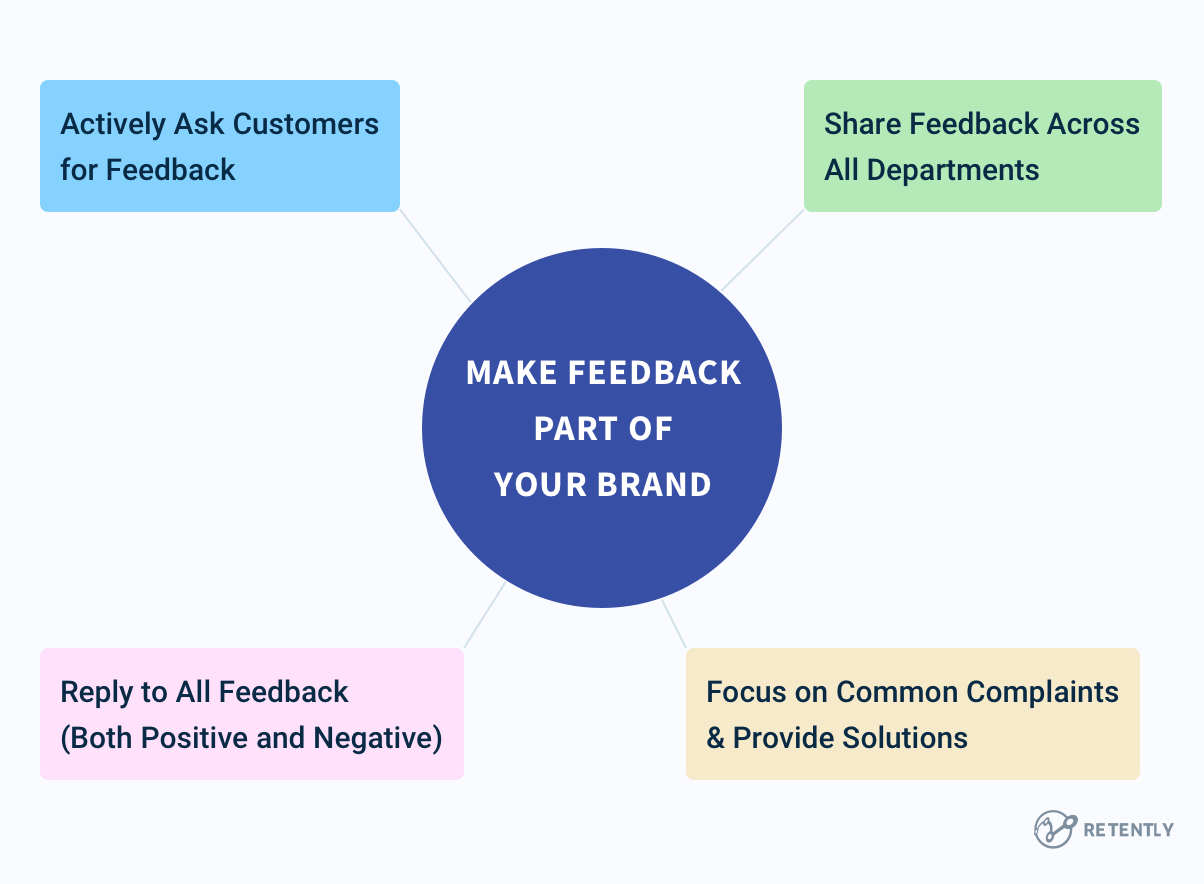
Want to Track Your Own Customer Satisfaction?
Running a VOC program and measuring your Net Promoter Score can tell you a lot about how customers view your business, and how satisfied they are with your products and services. But that’s not all – it also shows you which customer segments you need to focus on more (Detractors, Passives, Promoters) to improve satisfaction levels and which approaches to take.
And while we know that running customer satisfaction surveys might seem difficult if you don’t have any experience with them, we’ve got great news: You don’t need to worry about any complicated setups or anything like that since there already is an automated, fully-integrated platform built to support you with this – Retently.
Our service is very easy to use, works with other popular services like Intercom, Salesforce, Hubspot, etc. and makes it very simple to segment your customers and engage them on multiple channels.
Oh, and Retently features a free 7-day trial, too – no credit card required!






























 Greg Raileanu
Greg Raileanu 



 Christina Sol
Christina Sol 
 Alex Bitca
Alex Bitca 